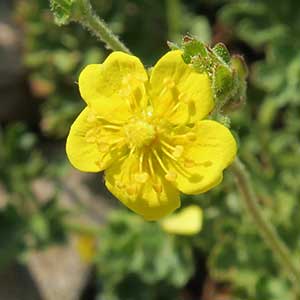Potentilla brevifolia
Potentilla litoralis
short-leaf cinquefoil, sparse-leaf cinquefoil
coast cinquefoil, Pennsylvania cinquefoil, potentille du littoral
decumbent to nearly erect, (0.4–)1–4.5(–6) dm.
petiole 1–4 cm, eglandular hairs absent or sparse, spreading, less than 1 mm, weak, glands abundant.
subpinnate to subpalmate, (3–)4–15(–25) cm;
petiole (1–)2–8(–15) cm, long hairs sparse to abundant, appressed to rarely ascending, ± 1 mm, ± stiff, short hairs absent or sparse, cottony or crisped hairs absent, glands ± sparse;
leaflets 2–3 per side, on distal 1/6–1/3(–1/2) of leaf axis, ± overlapping, terminal ones narrowly lanceolate to narrowly obovate, (1.5–)2–5(–7) × 1–2.5 cm, margins revolute, incised 3/4+ to midvein, undivided medial blade 2–10 mm wide, teeth (2–)5–8 per side, ± linear-elliptic, surfaces usually ± dissimilar, abaxial green to grayish, long hairs ± abundant especially on veins, 0.5–1.5 mm, weak, short hairs absent or sparse, cottony hairs absent, crisped hairs absent or sparse to abundant, glands ± abundant, adaxial ± green, long hairs sparse to common, ± appressed, 0.5–1.5 mm, short hairs absent or sparse, cottony hairs absent, crisped hairs absent or sparse, glands ± abundant.
(1–)2–4.
(1–)5–30-flowered, congested, scarcely lengthening in fruit.
0.2–1 cm (proximal to 3 cm).
epicalyx bractlets lanceolate-elliptic to ovate, 2–4 × 0.8–2 mm;
sepals 3–5(–7) mm, apex broadly acute to obtuse;
petals 3.5–6.5 × 3–5 mm;
filaments 1–2.5 mm, anthers 0.5–0.6 mm;
carpels 10–15.
epicalyx bractlets narrowly, rarely broadly, elliptic to linear, 2.5–5(–6) × 1(–2) mm, lengths ± 2/3 to equal to sepals, margins ± revolute (at least in fruit);
hypanthium 3–5 mm diam.;
sepals 3–6 mm, apex ± acute, abaxial surfaces: venation moderate, glands abundant, evident at least distally;
petals yellow, 3–5 × 2–4 mm, lengths ± equal to sepals;
filaments (0.5–)1–1.5 mm, anthers 0.3–0.5 mm;
carpels 50–100, styles papillate-swollen in proximal 1/2–3/4+, 1–1.5 mm.
1–1.5 mm.
± 1 mm, smooth to faintly rugose.
= 28, 56.
Potentilla brevifolia
Potentilla litoralis
Potentilla brevifolia is found mainly in alpine situations in the Pioneer, Sawtooth, Smoky, and White Cloud mountains of central Idaho; the Madison Range of western Montana; the Jarbidge Range of northeastern Nevada; the Blue, Steens, and Wallowa mountains of eastern Oregon; and the Teton Range of northwestern Wyoming. The elongate caudices are easily covered by moving soil and talus.
(Discussion copyrighted by Flora of North America; reprinted with permission.)
Revolute epicalyx bractlets and visible glands on the sepal tips are the most reliable characteristics to distinguish Potentilla litoralis from P. bipinnatifida where their ranges overlap in the northern Great Plains. The former is also more likely to be decumbent-ascending and tends to darken more in drying. Intermediates occur, as well as possible hybrids with P. bimundorum, P. hippiana, and P. pensylvanica.
Rydberg described Potentilla litoralis to accommodate the coastal phase of this species, concentrated around the Gulf of St. Lawrence and along the north Atlantic Coast as far south as New Hampshire. Potentilla pectinata Rafinesque was briefly adopted as the older name (for example, Frère Marie-Victorin 1935); it is both superfluous and a later homonym (B. Boivin 1952). The homotypic synonyms P. pensylvanica var. glabrata (Lehmann) S. Watson, P. bipinnatifida var. glabrata (Lehmann) Kohli & Packer, and P. glabrella Rydberg have been misapplied to P. litoralis; the type is a specimen of P. ovina var. ovina (sect. Multijugae) (J. Soják 1996). The type of P. dissecta Pursh, traditionally applied to P. glaucophylla (sect. Graciles), is closest to this species but has palmate leaves; ambiguity has led to the name being rejected (B. Ertter et al. 2008).
The current circumscription of Potentilla litoralis includes prairie populations extending through the northern Great Plains and boreal regions into eastern Alaska; those plants have generally been called P. virgulata when not combined with P. bipinnatifida, P. multifida in the broad sense, or P. pensylvanica. Outlying populations occur at least as far south as Wyoming (including the type of P. virgulata), central Nevada (possibly as introductions), and, possibly, Colorado.
Other than the tendency of prairie plants to be somewhat larger and more erect than the coastal plants, no significant morphologic distinctions have been found to match the differences in habitat and distribution. Based on their distribution map, B. L. Kohli and J. G. Packer (1976) considered the coastal and prairie populations, as well as what is here separated as Potentilla jepsonii, to comprise a single taxon, which they called P. bipinnatifida var. glabrata (Lehmann) Kohli & Packer (misapplied).
If Potentilla litoralis is treated as a variety of another species, var. virgulata has priority at varietal rank.
Unequivocal Potentilla litoralis barely enters Alaska; the majority of collections from central, western, and northern Alaska previously placed in P. litoralis represent an undescribed taxon whose dimensions are not included in the preceding description. Significant differences include more deeply incised leaflets with fewer teeth, flat, linear epicalyx bractlets, and larger petals. Some collections from around Kotzebue with relatively wide sepals and sparse glands may indicate hybridization with P. bimundorum.
(Discussion copyrighted by Flora of North America; reprinted with permission.)


